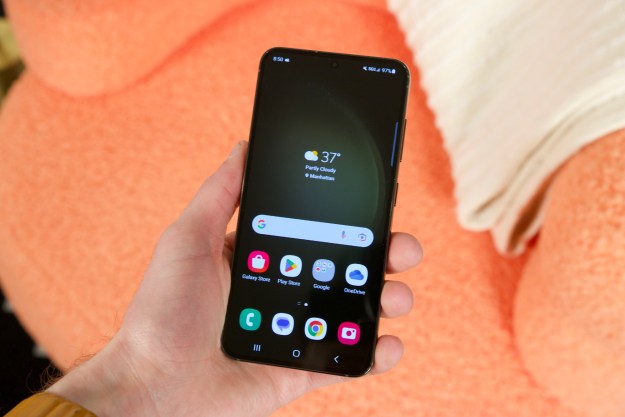“Design, sound clarity, simplicity, and functionality all balance elegantly in the JX10 package from Jabra.”
- Tiny; good sound clarity; includes charging dock
- Ear clip easily loosened; expensive
Summary
One of the most noticeable qualities of the Jabra flagship JX10 Bluetooth headset is its sleek design. The swooping curves, diminutive size, and featherweight body speak to the detailed attention paid to industrial design. In a sea of boring plastic headsets, the JX10 sticks out like a supermodel at a hot dog eating contest! But, does function follow this form? Read on to find out more…
Features and Design
There are three camps in the battle of the Bluetooth headsets. Some offer only the basics wrapped in a moderately pleasing package. Others cram as much functionality as possible into an earpiece. And still others throw their money into offering the sleekest design possible, while attempting to avoid compromises in functionality. Unlike other gadgets that generally find one company supporting a single class, many Bluetooth headset makers span the gamut, offering at least one option in each category. Our earlier review of the Jabra BT800 provided some insight into that feature packed offering by the headset giant. Now we get to see what happens when Jabra sports their Sunday best. The JX10 is the result of Jabra’s technical know-how and world famous designer Timothy Jacob Jensen’s industrial design skills.
The JX10 headset sports the most elegant style of a gadget in this category. At 1/3 oz. and 1.5 inches it is easy to forget you’re wearing this headset. While it’s not the smallest headset on the market, the JX10 can easily be mistaken for keys in a purse or pocket. The body of the unit can be used alone, or with the provided flexible rubber ear hook. Being able to remove the hook allows the wearer to switch ears. We found that once the ear hook was removed, it was generally difficult to reattach securely, even when properly latched. When used without the ear hook, the JX10 feels slightly awkward, as if it could fall off (even though we had no problems keeping it anchored). A ring of rubber material increases friction enough to keep the headset in place, even during the dreaded “shoe tying test.” We were able to crouch down, with our head 90 degrees to the floor without the JX10 falling out. In either configuration, once acclimated, the JX10 is a pleasure to wear.
There are only three everyday use buttons on the JX10. Answer/end, volume up, and volume down are all the user needs to worry about, making this one of the simplest interfaces of any Bluetooth headset. A tiny, frosted triple LED window indicates the status and battery level of the headset. Along the inside edge is an extremely small pairing button. We were glad to see that the button is very hard to press accidentally, but didn’t require a custom tool or paperclip. We were somewhat disappointed that there was no mute button, as it looks like there could have been a button placed along the top edge. Using the JX10 involves ‘tapping’ and ‘pressing’ the answer/end button. For instance, to answer a call on call waiting, press (and hold for 1 second) the answer/end button to switch between conversations, and tap (brief press) the same button to end the active conversation.
Next to the volume buttons is a concealed charging port. The JX10 ships with a stylish, solidly built charging dock that makes the charging headset look more like a work of art than a gadget, especially when the ear hook is detached. When away from home, the supplied micro USB charging cable can be used to charge the integrated lithium polymer battery via laptop. Jabra advertises 6 hours of talk time and 200 hours of standby. We found standby time to be approximately 8.5 days, or 204 hours. Similarly, we managed to eek out 5 hours of talk time. When not in use, the JX10 can be stored in a carrying pouch, also supplied by Jabra.
Jabra JX10
Performance
The noise canceling microphone uses digital signal processing to remove background noise and hone in on the speaker’s voice. The microphone itself is a tiny pinhole in the plastic, keeping water and debris out, and avoiding the discoloration that can occur with a fabric cover. Because there is no boom, no screening material is needed to eliminate pops and hisses from voice. Initially, during our testing, we had a few issues pairing the JX10 with our SonyEricsson 910a. After a few quick reboots of the phone and reentering of the profile, we were off and running without any further issues. The audio quality in quiet environments is simply excellent. Loud indoor environments suffered from some slight noise, but sound clarity was overall very satisfactory. Outdoor settings, the bane of many headsets, contained an average amount of wind noise. The wind rushing against the microphone is interpreted by the software as loud noise, boosting the unit’s gain. Essentially, the wind sounds loud to the headset so it adjusts the volume cut off. As a result, the user’s voice is reduced in volume to imperceptible levels. Through some fancy programming, Jabra was able to detect wind noise in some cases, but when wind gusts began or ended, the mic would cut out. Sustained winds actually fared better in our tests, as the DSP would normalize after a second, canceling out much of the wind noise. What should be put in perspective is that all headsets have similar weak points across these tests, but the JX10 handled them all in a more than satisfactory manner.
The back of the JX10
The JX10
Conclusion
You will be paying a premium price for this piece, but the two year warranty and quality design can almost make you forget! At $179, the JX10 doesn’t come cheap, but if you want a quality headset with an excellent minimalist design, look no further. Design, sound clarity, simplicity, and functionality all balance elegantly in the JX10 package from Jabra.
Pros:
- Tiny
- Good sound clarity
- Comes with a charging dock
Cons:
- Ear clip easily loosened
- Expensive
Editors' Recommendations
- YouTuber MKBHD says this new gadget is the worst he’s ever reviewed
- The 10 best photo editing apps for Android and iOS in 2024
- Best over-the-counter hearing aids for 2024
- The 10 accessories you need for your Samsung Galaxy S24
- The best Samsung Galaxy S24 screen protectors: our 10 favorites






